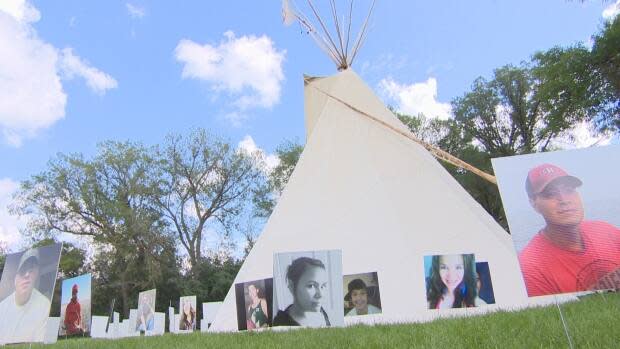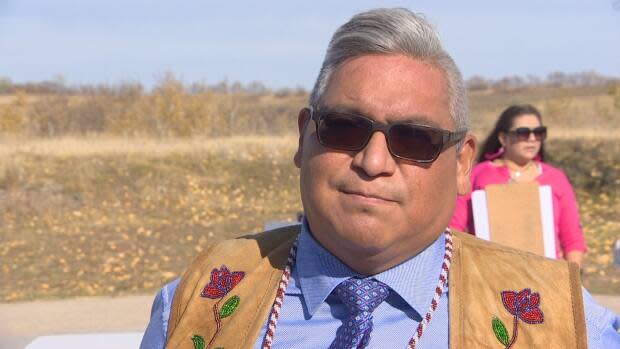Evolving relationships contribute to changes in addressing Sask.'s suicide numbers

In 2016, months into the most recent government's term, there was a rash of suicides in central Saskatchewan.
Six children between the age of 10 and 14 from La Ronge, Stanley Mission, Deschambault Lake and Makwa Sahgaiehcan died by suicide.
Then-premier Brad Wall travelled to La Ronge and attended a meeting with community leaders and said despite the tough budgeting that needed to be done in Saskatchewan at the time, "there's certain things for which you say, 'Let's not worry about that.'"
Between 2016 and April of this year, the Saskatchewan Coroners Service reported 820 deaths by suicide — not including medically assisted deaths.
Makwa Sahgeican and Ochapowace were two Indigenous communities that declared health emergencies related to suicides.
But things may be improving.
Construction is now underway on a 24-bed facility in La Ronge to serve the mental health and addictions needs in northern Saskatchewan after years of calls for better access to those services in the region.
Federation of Sovereign Indigenous Nations (FSIN) Vice Chief David Pratt, who took office in 2017 and handles the organization's health portfolio, said he's seen improvement at the provincial level when it comes to addressing Saskatchewan's suicide rates.
He pointed to an agreement signed between FSIN, the province and the federal government earlier this fall as one example of progress that's being made in addressing suicide in Saskatchewan.
"All three of us recognize that it is an issue and all three of us agreed that we would work together to address that issue," Pratt said.
"I think that the relationships have evolved and they've improved and I think that we're going to build upon that and we're going to see some good, good news."
Recapping recent history
Saskatchewan's suicide rates became a prominent discussion provincially through the summer months.
Doyle Vermette, the NDP candidate for the Cumberland electoral district, put forward his party's bill that would have required the provincial government to establish a provincial suicide prevention strategy that recognized suicide as a public health issue.
"The intent of [Vermette's] bill was to move forward with a suicide prevention plan. We've done that," then-health minister and Sask. Party candidate for the Rosetown-Elrose district Jim Reiter said the day the bill was defeated.
Reiter highlighted the party's Pillars of Life's policy directives that day as how the Sask. Party was looking to work toward a suicide prevention plan.
"Policy is more flexible. We don't think it needs to be in legislation, but the sincerity and the intent of his bill, I have no question."
The rejection of Vermette's proposal led Tristen Durocher to walk over 630 kilometres from La Ronge to the steps of the Saskatchewan Legislature building in Regina and host a 44-day ceremonial fast.
During the leadership debate, Durocher's journey and ceremonial fast were addressed when Meili asked Moe why he hadn't visited with Durocher while he was in Regina and instead "kicked him off the lawn."
Moe said Durocher met with the highest levels of government in meeting two ministers while he was in the province's capital.
"I think it's important for us all to realize that everyone agrees with what Mr. Durocher is advocating for," Moe said.
"He's advocating for the investment and the recognition of something that we all need to do and we all need to work collaboratively on reducing Indigenous suicides and reducing suicides in northern Saskatchewan."
Pratt agreed with Moe's assessment of the situation and said collaboration between FSIN and the provincial government and all parties impacted by the high rates of suicide in Saskatchewan could lead to solutions for all parties.
He said the province's Pillars of Life strategy complimented the FSIN's own suicide prevention strategy and noted there won't be a "one-size-fits-all" approach to solving the issue as the needs of every community in Saskatchewan are wide-ranging and diverse.
But Pratt said he expects to see dramatic positive changes in the next five years.
"If we can get five-year commitments from both levels of government, if they will put their money where their mouth is … as long as we measure the data we can see those numbers come down," he said.
"If we don't do something, if governments don't address those numbers, they're only going to increase and go higher."
Past and promised spending
Mental health spending has increased since the 2016 suicides and subsequent budget announcements have lauded "record high increases" in the area generally.
Specific spending on suicide prevention methods were also outlined in some of those announcements.
In 2017 the provincial budget committed $250,000 to expand the Mental Health Commission of Canada's Roots of Hope Suicide Prevention Initiative to Buffalo Narrows, making that northern village the third community to join the program.
In 2018 the budget committed $11.4 million of both federal and provincial money to "targeted investments in mental health," among which included expansion of the Mental Health Commission of Canada's suicide prevention demonstration project.

In 2019 another $250,000 was budgeted to the Mental Health Commission of Canada's Roots of Hope Suicide Prevention Initiative in Buffalo Narrows.
Earlier this year the province committed $1.25 million specifically to suicide prevention in its budget for 2020.
Pratt said the most recent promised spending made him optimistic.
"That is just an initial start from them, it's basically seed money to get the work started on suicide prevention," he said, adding he was pleased with the overall mental health spending increases he'd seen from the province.
During the leadership debate hosted earlier this month, NDP Leader Ryan Meili asked Sask. Party Leader Scott Moe why his party voted against a suicide prevention proposed by the NDP earlier this year.
"Legislation is not required to work on something as important as suicides," Moe said.
WATCH | Meili asks Moe why he didn't visit Durocher
Moe cited the government's Pillars of Life strategy, which he said engages with partners throughout Saskatchewan in important discussions around suicide, and a recent agreement the province signed with the FSIN and the federal government.
Moe said his government is taking the issue very seriously and pointed to a $30 million increase in mental health spending announced in the previous budget, which he said the government is ensuring comes with "real outcomes" for Saskatchewan communities.
"That builds on a $30 million investment the year before," Moe said, adding he believes it will take some time to find solutions to Saskatchewan's high rate of suicides.
Meili's party, in an election announcement, committed to immediately legislating a suicide prevention strategy with a budget of $5 million, should his party be elected to govern after Monday's vote.
The NDP has also promised to open mental health emergency rooms in Saskatoon, Regina, Prince Albert and Moose Jaw, and spend an extra $10 million on addiction treatment support.
Regardless of who is elected, Pratt said he and the FSIN are optimistic the government of Saskatchewan will work to adequately address the provincial suicide rate — in Indigenous communities and throughout the province.
Annual advocate reports highlight ongoing issue
Youth suicides in particular have been touched on in annual reports issued by the provincial Children's Advocate between 2017, the first issued after the suicide crisis in 2016, and 2019 the most recent report available.
The 2017 report called for all levels of government — First Nations, federal, provincial and municipal — to work together to address the problem.
By the 2019 report, the Children's Advocate was still citing suicide and self-harm as major risks to young people.
Deaths by suicide, attempted suicide and self-harm related incidents accounted for 28 per cent of the critical injury or death notifications the Children's Advocate tracked through the year.
In 2019, the report said Indigenous youth and children accounted for 85 per cent of the youth that died and 90 per cent of those that were critically injured in the data the advocate reported.
"This ongoing trend is unacceptable and highlights the urgency with which our province must embrace reconciliation," the report said.
"All sectors must work together to improve outcomes for Indigenous children."
The 2019 report highlighted one example of sectors coming together through a collaboration between the advocate and the provincial ministry of corrections and policing, which came about due to the number of deaths by suicide and attempted suicides by youth within the criminal justice system.
The 2019 report commended the ministry for its efforts in the collaboration, which resulted in a ministry-developed Critical Injury and Death Workplan.
When asked specific questions about the government's efforts around youth suicide prevention the Saskatchewan Advocate for Children and Youth said it was unable to comment on the matter.
"Given our status as an Independent Office of the Legislative Assembly, we respect the election process, and do not speak publicly during the election period," an emailed response said.
Where to go from here?
Pratt identified three different areas throughout North America where successful suicide prevention strategies were implemented that Saskatchewan could look to.
He looked south of the border to Arizona, where from 2001 and 2006, the Fort Apache Indian Reservation averaged 40 suicides per 100,000 people. Between 2007 and 2012 the rate dropped to an average of 24.7 suicides per 100,000 people, after a suicide prevention strategy was implemented there.
He also noted suicide strategies were implemented in Inuit communities and in Quebec with successful results.
A component those programs used was a connection to culture and land, he said, which is something he said sometimes gets forgotten in other approaches to suicide prevention.
"That's an element we're forgetting about. We're not focusing on the spirituality," he said.
"Yes, we're focusing on the physical, making sure people are clean and have clothes and a home … that's all a part of suicide prevention. But we have to focus on spirituality and getting people reconnected to their Creator — however which way they chose."
Pratt noted that regardless of the suicide prevention strategy that's implemented, FSIN will support communities, tribal councils and bands, who he said are the real drivers of the plans.

